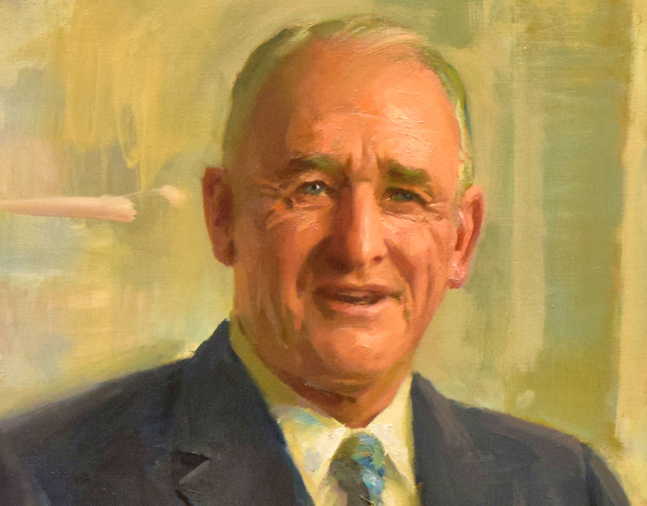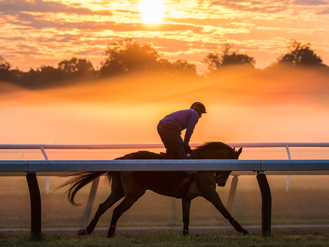James Cox Brady
The career of James Cox Brady was one of strength in leadership and contributions to the best interests of thoroughbred racing. At the same time, it can be seen as a chapter in a winding family story, with both preceding and continuing chapters wrought by relatives.

2022
July 28, 1907, West End, New Jersey
May 25, 1971, Summit, New Jersey
Biography
The career of James Cox Brady was one of strength in leadership and contributions to the best interests of thoroughbred racing. At the same time, it can be seen as a chapter in a winding family story, with both preceding and continuing chapters wrought by relatives.
Brady had a thread-like connection to racing history as far back as 19th-century champions Himyar and Domino, beacons of American bloodlines. That connection came via Brady’s father, who for three years in the 1920s owned historic Dixiana Farm in Kentucky. Dixiana occupies property where Maj. Barak G. Thomas had bred Himyar, who in turn sired Hall of Fame member Domino.
James Cox Brady’s father, also named James Brady, was a son of Anthony N. Brady, who was the leading shareholder in the American Tobacco Company in the late 1800s. The senior James Brady inherited the family fortune in 1918 and thus became one of the 30 richest Americans. He passed away only nine years later.
In the young career of James Cox Brady, it was a horse purchased by his father which was much more of a direct factor than was the brief ownership of Dixiana. In 1925, the elder James Brady had paid a spectacular record price for the day, $50,500, for a yearling filly by Man o' War. He named her War Feathers.
When James Cox Brady began his own racing operation, his earliest stakes success came from three sons and daughters of War Feathers, although the mare herself had not been inherited. The best of these was War Plumage, who won two of New York’s most important filly races, the Coaching Club American Oaks and the Alabama Stakes, in 1939. The following year, War Plumage defeated Santa Anita Handicap winner Kayak II and other males in the Washington Park Handicap. That victory and her stakes placings during the year were enough to earn her championship status. She was voted champion in what was then named the Handicap Female division in the fifth year of Daily Racing Form’s championship polls.
World War II intervened, and James Cox Brady served as a commander in the Pacific. He earned the bronze star and six battle stars. Afterward, he returned to the business world and the horse world. In addition to thoroughbred racing, he was interested in promoting American performance horses in international horse shows. The family’s elaborate Hamilton Farm in New Jersey eventually was provided as training headquarters for the United States Equestrian Team.
Born in New Jersey and educated at Yale, Brady followed business activities built on family history. Throughout the years, he served as chairman of the board of Brady Security & Realty as well as Purolator Products and was a director of various other corporations, including Chrysler.
James Cox Brady was elected to The Jockey Club in 1961, and service to sport was provided through that and other posts. Looking back on Brady’s service following his death in 1971, Kent Hollingsworth, editor of The BloodHorse, commented that “Belmont Park today represents a good deal of James Cox Brady. He was a thoughtful man of keen intellect and forceful determination unsuspected before his election in 1961 to succeed John W. Hanes as chairman of the New York Racing Association.”
In the years immediately prior to Brady’s chairmanship appointment, and in years afterward, New York had faced various challenges to maintain its reputation as the most important of racing circuits. During the 1950s, New York racing had been challenged by the state racing commission to right its ship on its own or else face state intervention. John W. Hanes had been one of a committee of three appointed by The Jockey Club Vice Chairman, Ogden Phipps, to develop a plan. The two others on the committee were Capt. Harry Guggenheim and Christopher T. Chenery.
Hanes, Guggenheim, and Chenery devised a plan to borrow major money to renovate one of the New York City tracks, Aqueduct, to the highest standards of the day. The plan also involved selling off the Jamaica and Empire City tracks, so that Aqueduct and Belmont Park would be the only tracks in the Metropolitan area. The overall project also recognized the importance of improving the upstate track, historic Saratoga. The tracks had been under separate ownership, but the committee’s vision was that all three be acquired by an entity named the Greater New York Association. This quasi-governmental body later was officially named the New York Racing Association.
By the time grand new Aqueduct was re-opened in 1959 and hailed as The Big A, the shadow of proposed off-track betting also was lurking in the environment. Racing leaders tended to be against off-track betting, but when it did come about, their efforts had created a way that it supplemented rather than ravaged the industry’s share of betting handle.
Other problems faced Brady and NYRA, however. By 1962, the condition of the bellwether New York track, Belmont Park, had deteriorated to the extent that it had to be condemned. Thus, Brady and his compatriots faced a huge undertaking right when the most damaging possibilities of off-track betting were still brewing. As things transpired, a new and spacious Belmont Park opened in 1968 in time for the 100th running of the state’s signature classic, the Belmont Stakes.
While the ability of New York sportsmen to retain physical management of the racing game in those years had been paramount, Brady also found ways to refine and improve the sport he had grown to love. As recounted by Hollingsworth following Brady’s death, “While rebuilding of Belmont Park was the most obvious, there were other accomplishments during Brady’s eight-year tenure as head of NYRA. He rendered structurally sound while retaining the aging dignity of racing’s Dowager Queen — Saratoga. He sponsored more filly racing and nurtured distance racing.”
Hollingsworth summarized: “An investment banker by trade … he got the money to raise purses and rebuild the plants by negotiating with the state to permit greater retention of pari-mutuel takeout and by refinancing the long-term mortgage.”
As head of NYRA and as vice chairman of The Jockey Club, Brady’s primary visibility within the sport usually was of matters relative to finances, rules, and institutional well-being. Brady also was a founding director of the modern Monmouth Park in his home state of New Jersey, and he found time to chair the state’s Thoroughbred Horse Breeders Association. As a breeder and owner, however, he also had remained active and successful. His personal number of stakes winners raced reached 15, most of them homebreds. His best runners included Artismo, Casemate, Landlocked, and Top Round. A singular moment came in 1965, when Brady won one of England’s noble classic races, the Epsom Oaks, with homebred Long Look.
James Cox Brady was only 63 when he passed away in 1971. Both of his sons, Nicholas F. Brady and James C. Brady, had followed the family traditions in racing. In addition to individual involvement, the Brady family of sons and daughters operated a breeding and racing enterprise under the name Mill House. Nicholas F. Brady became chairman of The Jockey Club three years after the father’s passing, serving in that post for eight years.
Achievements
— Chairman of the New York Racing Association 1961 through 1968
— Elected to The Jockey Club 1961 (served organization as a steward and vice chairman)
— Campaigned champion filly War Plumage
— Thoroughbred Club of America’s Honored Guest 1970
Media





